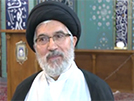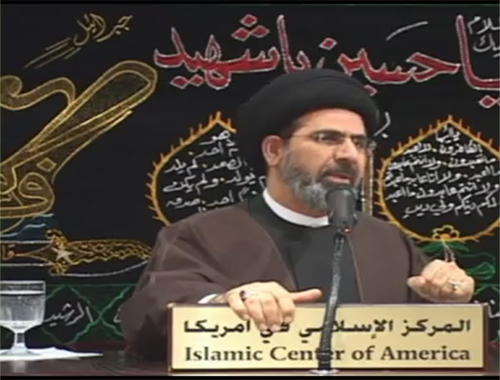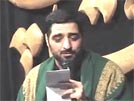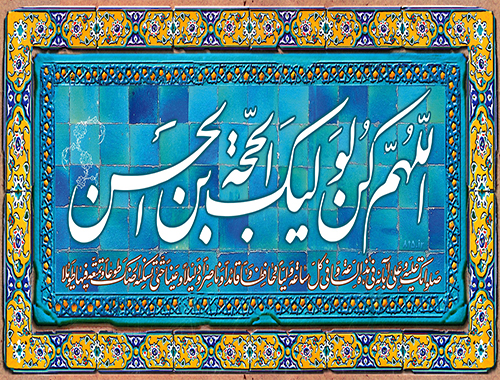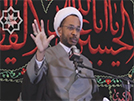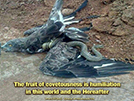Chapter 1-Conceptual Foundations
- Details
- Hits: 12998
Chapter 1
Conceptual Foundations
The division of the community of Islam into Sunni and Shi'i
branches has commonly been explained in terms of purely
political differences. Its origins have been attributed to
basically political partisanship with regard to the leadership
of the Umma, a partisanship which later exploded into
conflict in the civil war between 'Ali and Mu'awiya This war
not only established the Umayyads in power, but also
supposedly marked the advent of Shi'ism as a religious
movement divergent from the main body of believers. Such
an interpretation grossly oversimplifies a very complex
situation. Those who thus emphasize the political nature of
Shi'ism are perhaps too eager to project the modern Western
notion of the separation of church and state back into seventh.
century Arabian society, where such a notion would be not
only foreign, but completely unintelligible. Such an approach
also implies the spontaneous appearance of Shi'ism rather
than its gradual emergence and development within Islamic
society. The recent occidental conception of "a purely spiritual
movement" is exceptional. Throughout most of human
history religion has been intimately involved in the whole life
of man in society, and not least in his politics. Even the purely
religious teaching of Jesus-as it is commonly regarded-is
not without its political relevance.1
Just as the Prophet was basically a religious and spiritual
teacher and messenger and, at the same time, due to the
circumstances, a temporal ruler and statesman, Islam has
been since its very birth both a religious discipline and, so to
speak, a socio-political movement. It is basically religious
because of the status Muhammad attained as the Apostle of
God appointed and sent by Him to deliver His message to
mankind, and political because of the environment and
circumstances in which it arose and grew. Likewise Shi'ism,
in its inherent nature, has always been both religious and
political, and these co-existing aspects are found side by side
throughout its history. It is therefore difficult to speak, at any
stage of its existence, about the "political" Shi'a as distinct
from the "religious" one. Throughout the first three or four
centuries of Islamic religious and institutional development,
one cannot fail to see that all religious discussions among
Muslims had both political and social relevance. When we
analyse different possible relations which the religious beliefs
and the political constitution in Islam bear to one another, we
find the claims and the doctrinal trends of the supporters of
'Ali more inclined towards the religious aspects than the
political ones; thus it seems paradoxical that the party whose
claims were based chiefly on spiritual and religious consid-
erations, as we shall examine in detail presently, should be
traditionally labelled as political in origin.
The term Shi'a, keeping in view its historical development,
must strictly be taken throughout this chapter in its literal
meaning as followers, party, group, associates, partisans, or in
a rather looser sense, the "supporters". 2 In these meanings the
word Shi'a occurs a number of times in the Qur'an. 3 In its
applied meaning as a particular designation for the followers
of 'Ali and the people of his house, and thereby a distinct
denomination within Islam against the Sunni, the term Shi'a
was a later usage. In the infant years of Islamic history, one
cannot speak of the so-called "orthodox" Sunna and the
"heretical" Shi'a, but rather only of two ill-defined points of
view that were nevertheless drifting steadily, and finally
irreconcilably, further apart. With this meaning of the term
Shi'a in mind, our main purpose here is to trace the
background of this support to 'All and to investigate its
origins in the Arabian society of the day in the midst of which
Islam arose. Consequently it will be illustrated how this
attitude became manifest as early as the death of the Prophet
Muhammad.
The starting point in any study of Shi'a Islam must, by
historical necessity, be the nature and composition of the
Muslim community which emerged at Medina under the
leadership of Muhammad. This community was homogeneous
neither in cultural background and traditions nor in
politico-social institutions. The unification of different people
or groups of people in a new system does not imply a complete
elimination or even a change in some of their deep-rooted
values and traditions. It was therefore natural that certain
values, ideas, and inclinations of different component parts of
the Umma should reflect themselves in certain aspects of the
new religious order. Consequently, rather than a homogen-
eous approach to all issues, especially of a non-fundamental
nature, one must expect to find in the Umma a multiplicity of
approaches and points of view, with the acceptance of
Muhammad and his mission being the fundamental factor
binding the various groups together.
The inclination of some of the Arabs from among the
Companions of the Prophet to support 'Ali was thus a natural
corollary of the already existing ideas prevalent among the
various Arab tribes who together constituted Muhammad's
Umma at Medina. This Umma consisted of the Meccans,
both from the Quraysh al-Bitah (those who inhabited the
district immediately around the Ka'ba) and Quraysh az-
Zawahir (those whose quarters were in the outskirts); of
Medinese, who were divided into Aws and Khazraj, both
tribes of the South Arabian stock and still preserving many
of the characteristics of their original land; of the desert Arabs
surrounding Med ma; and even of some Arabs and non-
Arabs from distant places, such as Bilal of Abyssinia and
Salman of Persia. All of them together formed a common
society under Islam, but when we consider a problem
common among them we have to take into consideration the
different temperaments and inclinations of each group, and
not those of only one single people, group, or locality. We
must presume that the Arabs of different origins and socio-
cultural backgrounds understood Islam, at least in its early
stage, according to their own social and moral ideas.
Arab society, both nomadic and sedentary, was organized
on a tribal basis, and of all the social bonds, loyalty to the
tribe
(al-'asabiya) was considered the most important. This feeling
of al-'asabiya, along with other aspects of tribal life, provides
the most emphatic expression of and a constant theme for
pre-Islamic poetry. The tribal system was based on the actual
or fictitious descent from a common ancestor through whom
the social and moral status of the members of the tribe was
determined. People who could not boast of their ancestors as
a symbol of greatness were of little social standing and often
subject to contempt. Knowledge and awareness of the
common ancestor was therefore the central point in Arab
social consciousness, and honour and glory of a tribe in
comparison with any other tribe consisted of the honour and
glory of its ancestors. Any claim to prestige and honour of the
individual members as well as the whole tribe was perhaps
exclusively dependent on that of the ancestors. The word
used for such claims is hasab, which is commonly explained
by the Arab philologists in the meaning of enumeration of
the famous deeds of ancestors. 4 This does not mean that the
word hasab excludes the enumeration of those ancestors
themselves who figure in the genealogical tree in both
paternal and maternal descent. 5 If the noble deeds of one's
ancestors are numerous enough to be cited and boastfully
enumerated by their descendants, the richer is their hasab or
sharaf as is evident from a popular expression, al-hasab or
sharaf al-dakham. 6 This means a nobility which becomes
"thicker" and stronger through accumulated noble deeds of
ancestors generation after generation. 7 Thus sings the famous
Arab poet Nabigha adh-Dhubyani:
"His father before him and his father's father
built the glories of life as models." 8
A tribe with large numbers but few deeds of fame to its credit
coming down from its ancestors was not only of less social
standing but also subject to mockery from those who could
enumerate more of their ancestors' noble deeds. So we hear
from the poet Damra as he says:
"And the joint stock which they have begotten
among the race of Sa'd and Malik:
but some of the fire-sticks of the tribe fail to light
and are nothing worth." 9
In a rigidly tribal system such as that of the Arabs, the fame
of ancestors for noble deeds was the foremost source of pride
and of claim to superiority. Nobility thus derived, a tribe
considered it a constellatory factor in claiming its higher
position in relation to other tribes. Within a tribe a particular
clan had higher claim to glory, and therefrom to leadership,
if its direct line of ancestors was more distinguished by their
noble deeds in relation to other clans of the same tribe. This
fame of ancestors was not mere genealogical ornament to the
descendants but had individual relevance to each man and
was of great significance in the claim of individual honour. 10
Thus, for example, Nu'man b. al-Mundhir, King of Hira,
asked Amir b. Uhaymir b. Bahdala, who had claimed the
highest rank among all present, "Are you then the noblest of
all Arabs in respect of your tribe?" He replied, "The Ma'add
excel in nobility and number, and amongst them the Nizar,
and amongst them the Mudar, and amongst them the
Khindif, amongst whom the Tamim, and amongst these the
'Awf, within 'Awf the family of Bahdala. He who does not
admit this may contest with me." 11
Not only physical characteristics were considered by the
Arabs to be hereditary ;12 they firmly believed that noble
qualities as well were inherent in certain stocks. Moral
qualities thus being genetically transmitted, the best virtues
for an individual were therefore only those which were
handed down to him from his noble ancestors. The Arabs
made a clear distinction between inherited nobility and
nobility claimed only on account of personal merit, the former
being a source of great social prestige while the latter was of
little consequence. In other words, personal fame and merit
counted for little in securing for oneself an exalted position;
it was inherited fame and inherited merit which confirmed
proper estimation in the society. 13 There are numerous
references in pre-Islamic poetry where ancestral nobility and
virtues are described as a strong and lofty building which
they built for their descendants 14 and which it would be
shameful for the latter to destroy. 15 Ancestral fame of nobility
and virtuous deeds must therefore be preserved as the
strongest and most continuous incentive to be adopted by the
descendants. It was in this sense that the term Sunna had
frequently been used long before Islam. 16 After Islam the
institution of Sunna remained as forceful as ever, but its
content was drastically replaced by the Prophetic Sunna.
Nevertheless certain trends of the original Sunna did persist,
at least in certain sections of the Arab-Muslim community.
The most privileged in Arab society, in the midst of which
Islam arose, was therefore the one who could boast publicly
that he was destined to have ancestors who had nothing
undistinguished to leave to him as their Sunna. A word
commonly used to express the idea of ability to trace moral
qualities back to one's noble ancestors is 'irq, (p1. a'raq and
'uruq). 'Irq means root, origin of a man, and its plural a'raq
signifies ancestors of a man. Thus frequent expressions of a
man's inheritance from noble ancestors are found in phrases
such as, "he has an hereditary share in generousness or
nobleness," 17 or "noble blood lifted him up to his ancestors." 18
It is clear that in the religious sentiments of the Arabs,
ancestral piety, noble deeds, and moral qualities as Sunna
played an important role. The religion of the Arabs, which
varied in strength and importance from locality to locality
throughout the peninsula, was originally the worship of tribal
symbols, which later became identified with certain forces of
nature represented by numerous deities. The tribal deity,
symbolized in the sacred stone (nasab), was called the lord
(rabb) of its temple. Allah, the supreme deity of the Meccan
sanctuary, was described as Rabb al-Ka'ba or Rabb Hadha al-
Bayt. 19 It is important to note that the word rabb often
referred not to the deity but to the person in charge of the
sanctuary.
There was no organized priestly hierarchy, but certain
clans acted as guardians of the sanctuaries. This guardianship
passed from one generation to another, together with the
reputation for hereditary sanctity. 20 This sanctity, which had
its original source in the magical power attributed to the idol
which they served, was strictly connected with the idea of
nobility of race (sharaf) synonymous with the pride of descent
from noble ancestors. The nobility of the clan being
hereditary, the priestly clans of long standing represented the
highest aristocracy in pre-Islamic Arabia. Traces of this sort
of aristocracy are to be found in the belief of the Arabs,
especially of the South, that members of certain families have
a charisma or spiritual power, or sharaf The guardianship of
a sanctuary, a "house" (Bayt), and "honour" (sharaf) came to
be understood as being inseparable. 21 As a result, priesthood
in Arabia was very often combined with tribal leadership,
even with kingship. We may go even further by stating that
political leadership there was originally of a religious and
priestly nature. The South Arabian monarchial institution of
the mukarrib is a clear proof of the office of the priest-king
who embraces at once religious and temporal authority.
The clans of political rulers could have attained the status
of great nobility after first acquiring power by political means,
but nevertheless, they could not equal the sacerdotal lineages;
for example, the kings of Kinda ranked only after the three
most noble priestly houses. These three houses, "after the
house of Hashim b. 'Abd Manaf amongst the Quraysh", were
Az-Zurara b. 'Udas of the Tamim, Al-Hudhayfa b. Badr of
the Fazari tribe, and Dhu'l-Jaddayn b. 'Abd Allah b.
Hammam of the Shayban tribe. "And as far as the Kinda
were concerned they were not counted amongst the ahi-al-
buyutat, even though they were the kings." 22
It is apparent that not only was priestly status the
foundation of political leadership, but when the latter was
attained by men of non-priestly clans, it imposed upon them
religious functions. They were also mediators between men
and deities. As a result, the idea of tribal leadership and
service to the God became synonymous. Those who led the
tribe were of necessity the guardians of the tribal bayt. They
were the ahl al-bayt, the "people of the house", or the bayt of
such and such a tribe. 23 Together these leading clans formed
the noble estate of Arabia, the buyutat al-'Arab. 24 Even later,
when the meaning of the ahl al-bayt became limited to the
descendants of the Prophet, the term Buyutat al-'Arab
survived into later centuries in the sense of the tribal
aristocracy and nobilitv. 25
It is against this background that we have to consider the
status of the Banu Hashim, not only among the people of
Mecca but in a wider circle due to their vast contacts with the
people of different places through the yearly fair of Ukaz and
the pilgrimage to the Ka'ba. Some western scholars have
sceptically questioned whether the ancestors of Muhammad
were really as important in dignity, nobility, and influence as
the sources suggest, and they usually claim that the importance
of the Banu Hashim has in fact been grossly exaggerated.
The basis of this doubt is that the 'Abbasids were descendants
of Hashim, whereas the rivals whom they ousted, the
Umayyads, were the descendants of 'Abd Shams, and that
the latter have been treated unsympathetically by the
historians who happened to write under the 'Abbasid regime.
For this reason, it is claimed that Hashim and his family, the
ancestors of the 'Abbasid caliphs, had been given greater
prominence in extant histories than they really possessed.
This entire hypothesis, however, is open to considerable
criticism. Scrutiny of the sources suggests that this has not
happened to any appreciable extent, and that there are no
grounds for assuming any serious falsification or large scale
invention in presenting Muhammad's ancestry. 26
There is no need to go as far back as Qusayy, father of 'Abd
ad-Dar and 'Abd Manaf, whom unanimous historical
testimony presents as the unrivalled supreme authority of
Mecca both in religion and in political matters. 27 After the
death of Qusayy, 'Abd ad-Dar inherited his father's authority,
but he died early and his sons were too young to effectively
maintain their rights. 'Abd Manaf, the younger son of
Qusayy, had been the powerful rival of his elder brother and
ultimately concentrated some of the chief offices of his father
in his person after the death of 'Abd ad-DAr. 28 Eventually the
sons of 'Abd Manaf inherited their father's influence; among
them, Hashim, though the youngest, was entrusted with the
most honourable offices pertaining to the Ka'ba, ar-r:f4da
and as-siqaya: providing food and water to the pilgrims. 29
There are no serious grounds to doubt the accounts given by
the early tradition that Hashim achieved great success and
glory in his lifetime by his acts of public welfare and by his
splendid hospitality extended to the pilgrims visiting the
Ka'ba from all parts of Arabia. 30 When Hashim died, he was
replaced by his brother AI-Muttalib. For a short time it seems
that the fortunes of the family were declining under the
leadership of Al-Muttalib, but they soon recovered under
Hashim's son 'Abd al-Muttalib, who had been brought up in
Medina with his mother and then brought to Mecca by his
uncle Al-Muttalib. 31
The other sons of Hashim having died without male issue,
'Abd al-Muttalib took charge of the family's affairs, which
meant the de facto merger of the Banu Hashim and Banu
'Abd al-Muttalib. This is not the place to discuss whether or
not the family of Hashim at that time was as prosperous and
influential in Meccan internal affairs as it used to be. The
same sources which are too often suspected of being biased in
presenting Muhammad's ancestors in unduly favourable
circumstances do not hesitate to relate how 'Abd al-Muttalib
faced serious set-backs at the beginning of his career. The
grand offices of ar-rifada and as-siqaya secured for the house
of Hashim a commanding and permanent influence, and it
seems natural that by the virtue of these offices a widespread
fame abroad must have guaranteed to the family at least some
regard in Mecca. 'Abd al-Muttalib seems to have been a man
of initiative and energy, 32 necessary prerequisites to become
a man of consequence in the Meccan merchant aristocracy.
He greatly enhanced his position by restoring the ancient
well of Zamzam. In the course of time, he became the chief
custodian of the Ka'ba and was also regarded as a renowned
judge of the customary law. Because of his position as the sole
person in charge of the main services pertaining to the most
respected sanctuary of the Peninsula, he became one of the
most, if not the most, prominent figures of Mecca. We are told
by Ibn Sa'd and Ibn Hashim that "he was the leader of the
Quraysh until his death," and that "his greatness in honour
(sharaf) attained an exalted position which no one from
amongst his fathers had reached before him. He commanded
great respect and the love of his people." 33
After 'Abd al-Muttalib's death, his eldest surviving son
Abu Talib inherited his father's position. It seems, however,
that Abu Talib did not prove himself to be of that same
calibre and energy as his father and grandfathers, and
consequently the family lost much of that power and
command which it had previously enjoyed in the inner circle
of Meccan aristocratic society. 34 Nevertheless it does not
necessarily follow that the material decline of the family's
fortunes should have deprived it, in the minds of the people,
of the memory of their immediate past. The regard for a
successor of three or four illustrious generations could not
have faded so soon, especially among groups beyond Mecca.
The sanctuary of the Ka'ba, a shrine of extreme antiquity,
was a highly important and popular centre of worship in the
Peninsula, 35 and its offices of as-siqaya and imarat al-bayt
(keeper of the Ka'ba) are noted in the Qur'an. 36 Supplying
the pilgrims with water must have been a lucrative job in
Mecca, where water is so scarce, and the water of Zamzam,
which soon shared in the sacredness of the sanctuary, was
required not only by the yearly pilgrims but also by the huge
trade caravans halting at Mecca. 37 Many early writers have
recorded detailed accounts of the universal influence of the
Ka'ba, of the vast contacts of the people of Mecca due to its
being a centre for the trade caravans from Yaman in the
South, from Dumat al-Jandal in the extreme North, and from
other far-off places, and of the Ukaz, the greatest of the Arabs'
yearly fairs. It is therefore natural that the honorific services
attached to the sanctuary and rendered by the house of
Hashim for such a long period must have extended the
family's fame and prestige over a very wide area as the
pilgrims and the caravans left Mecca. We can thus conclude
that at the time of Muhammad's emergence, his family must
have retained the glory and memory of the long-standing
sacerdotal lineage of Hashim even though the family's
material and political fortunes were at a low ebb at that time.
Psychologically at least, the works and deeds of three
generations cannot be obliterated from the consciousness of
the people abroad by the sudden decline in wealth and
political power of the present generation at Mecca. The Banu
Hashim were commonly recognized by the Arabs as the
guardians of the Temple, the Ahl al-Bayt, of Mecca. 38
It was in this family background that Muhammad arose as
the Messenger of God and restorer of the true religious Sunna
of Abraham and Ishmael 39 which had been corrupted and
distorted by the people through the ages. Abraham was not
only recognized by the Arabs as their tribal father and
progenitor but was also acknowledged by them as the founder
of the sanctuary of the Ka'ba and of Mecca. This tradition
was no Muslim legend. If it had not been an accepted truth
long before Muhammad's time, it could not have been
referred to in the Qur'an as an acknowledged fact; nor could
certain spots around the pre-Islamic Ka'ba have been
connected, as we know them to have been, with the names of
Abraham and Ishmael. 40 Muhammad was fully conscious of
this popular and deep-rooted tradition of Abraham's associa-
tion with the Ka'ba, with which the Arabs in general and
Muhammad's four generations of predecessors in particular
were so closely linked. Ibn Khaldun points out that it was
regarded as something extraordinary and most honourable if
the leadership continued in one and the same family for four
generations. 41
All the factors discussed above combine to form an
inseparable background against which the problem of
succession to Muhammad has to be considered. As has been
pointed out above, this problem must not be considered only
from the point of view of seventh century Meccan society, for
the Umma of Muhammad at the time of his death was
composed of people of a variety of background, values, and
ideas, drawn from different parts of Arabia. It was, therefore,
natural that different people should view the problem from
different angles. The way in which the problem of succession
was solved in the assembly of Saqifa between the death and
the burial of the Prophet will be discussed below. It will
suffice here to note in passing that the decision taken in Saqifa
was also in conformity with the common practice and ancient
tradition of the Arabs, at least of one important group from
among them.
The two main constituent groups of the Umma at the time
of Muhammad's death were the Arabs of northern and
central Arabia, of whom the tribe of the Quraysh was the
most important and dominant, and the people of South
Arabian origin, the Banu Qayla, whose two major branches,
the Aws and the Khazraj, were settled in Yathrib. They were
known as the Ansar, or "helpers", because they gave
Muhammad and Islam a shelter and a home at the most
critical moment of the Prophet's mission. Differences in
almost all aspects of life-social, cultural, economic, religious,
geographical, and even presumably racial and ancestral-
between the Arabs of the South and the North are too well
known to need elaboration here at length. Goldziher, 42
Wellhausen, 43 Nicholson, 44 and many other outstanding
scholars have thoroughly studied the subject in depth. It
should, however, be pointed out that to consider all the Arabs
as one single cultural group is a grave mistake. They had
never been so. The North was cut off from the centre by the
desert as the South was separated from the rest of Arabia by
the Rub 'al-Khali. Widely different geographical and eco-
nomic conditions played their inevitable and natural role in
every aspect of development of the two kindred races. The
Arabs of northern and central Arabia, the Hijaz, and the
highlands of Najd, developed along different lines from the
southern Arabs of Al-Yaman in character, way of life, and
socio-political and socio-religious institutions. Ag in all other
aspects of life, the two groups differed widely from each other
in religious sensitivity and feelings. Among the people of the
much more advanced and civilized provinces of South Arabia
there was a clear predominance of religious ideas, whereas
among the people of the North religious sentiments were
evidently lacking. A South Arabian prince, for example, in
his votive inscriptions thanked the gods who made him
victorious over his enemies, and warriors erected votive
memorials to their divine helper for any success they achieved.
In general the thankful and submissive feeling towards the
gods is the basic theme of the existent South Arabian
monuments. In sharp contrast to this, the warriors of northern
Arabia boasted of their heroic courage and the bravery of
their companions. They did not feel obliged to thank divine
powers for their success, though they did not altogether refuse
to acknowledge such powers. 45 Even the scanty traces of
lukewarm religious sentiments amongst the northern Arabs
cannot be dissociated from the influence 9f the southern
Arabs settled down in the North. 46 This difference in
religious sentiments was naturally reflected in their pattern
of tribal leadership. The chiefs or the sheikhs in the North
had always been elected on a principle of seniority in age and
ability in leadership. There might sometimes be other
considerations, such as nobility and lineal prestige, but in the
North these were of less importance. The Arabs in the South
were, on the other hand, accustomed to hereditary succession
in leadership based on hereditary sanctity. Because of this
fact the South Arabian tribes of the Aws and the Khazraj at
Yathrib presented an atmosphere more easily conducive to
the religious thought which was of great importance in
Muhammad's success. Thus we may assume that the majority
of the North Arabians understood Islam, at least at the first
stage of their acceptance of it, as a socio-political discipline
based on the religion taught by the Prophet, since they had
been lukewarm to religious impulses. The Aws and the
Khazraj, South Arabian in origin, understood Islam as
basically a religious discipline coupled with a socio-political
movement, since in their cultural past, though remote, they
had been more sensitive to religion. It was only a matter of
emphasis in approach and understanding, at least at the first
spontaneous response.
When the Prophet died the question of his succession was
therefore understood to combine in it both political and
religious leadership, a principle well known to the Arabs
though naturally with different degrees of emphasis on one
or the other of these two aspects. To some it was more political
than religious; to others it was more religious than political
The majority of the Muslims, who readily accepted Abu
Bakr, laid more emphasis on the sociopolitical side in
accepting the customary procedure of succession to the
chieftainship in its new interpretation given by the first
caliph, as we shall examine below. They largely, if not solely,
disregarded the religious principle and the idea of the
hereditary sanctity of a certain house. This assumption is
strongly supported by the statement of 'Umar b. al-Khattab
to Ibn 'Abbas, "The people do not like having the prophethood.
and caliphate combined in the Banu Hishim." 47 We must
assume that both 'Umar and Abu Bakr were well aware of the
importance which the idea of inherited sanctity held in one
section of the Umma. At the same time they must have
realized that should the election of Abu Bakr be open to
doubt, the unity of the Umma would be seriously endangered.
They nevertheless considered it necessary to dissociate the
caliphate from the priesthood of the Ka'ba, which was
enshrined in the hereditary sanctity of the Banu Hashim.
There were others, especially of South Arabian origin; who
felt that in Mecca leadership, together with priestly preroga-
tives, was inherited in the clan of 'Abd Manaf by the
Hashimites, 48 though after the death of 'Abd al-Muttalib they
were overshadowed by the clan of Umayya in political
matters. The rise of Muhammad as the Prophet of God and
the supreme authority in Arabia again brought the Banu
Hashim to power, a fact acknowledged by Abu Sufyan's
surrender to the Prophet at the fall of Mecca. To some of the
Companions, therefore, a normal logical choice of successor
would have been another Hashimite, and the entire question
of succession to the leadership of the Muslim community
was, for them, a problem of great religious significance. In
addition to political expediency, deep-rooted religious
considerations had to be taken into account by certain of the
Companions. These, whom we may call more legalistically
minded individuals, could not agree to the interpretation
given by Abu Bakr and his supporters, because, as we shall
see below, they understood the leadership of the community
as above all a religious office. To them Muhammad was the
restorer of the true religion of Abraham and Ishmael, and so
in him the hereditary sanctity of his clan reached its highest
level. This idea was also strongly supported by the Qur'an
when it declared, for example, "Verily, God has chosen Adam
and Noah, the family of Abraham and the family of 'Imran
above all people."' 49 The commentators have all unanimously
explained that Muhammad belonged to the "family of
Abraham" referred to in this verse. Thus when he died his
successor could only be a man from the same family and
endowed with the same qualities by the same principles.
In this respect, there must be noted the Qur'anic concept of
the exalted and virtuous family, whose favour in the eyes of
God derives from their righteous deeds and services in the
cause of God. In all ages the prophets have been particularly
concerned with ensuring that the special favour of God
bestowed upon them for the guidance of man be maintained
in their families and pass to their progeny. The Qur'an
repeatedly speaks of the prophets praying to God for their
progeny and asking Him to continue His guidance in their
lineages. In the answer to these prayers, the verses of the
Qur'an bear direct testimony to the special favour of God
being granted to the direct descendants of the prophets to
keep their fathers' covenants intact, to become true examples
of their fathers' righteousness, and to keep fast to the path of
righteousness set by these prophets. Four terms are repeatedly
used in the Qur'an to express God's special favour for the
descendants of the prophets: Dhurriya, Al Ahl, and Qurba.
The word Dhurriya, meaning offspring, progeny, or direct
descendant, has been used in thirty-two verses of the Qur'an.
It is used either in direct connection with the prophets' own
concern that their children should remain on their path or
that their work of guidance should be continued through
their own progeny. Often the word is used in verses where the
prophets claim that God had selected them to become models
of righteousness based on their direct descent from other
prophets. This concern for a prophet's progeny is reflected in
a verse (II, 124) where Abraham was told by God: "I will make
you an Imam of the people." Whereupon Abraham pleads,
"And what about my offspring (Dhurriyati)?" God replies,
"My covenant will not go to evildoers." In a similar verse (XIV,
37) Abraham prays to God:
"Oh my Lord God! I have made some of my offspring to dwell
in a valley without cultivation by the Sacred House, in order, Oh
Lord, that they may establish regular prayer: so fill the hearts
of
some among men with love towards them and feed them with
fruits: so that they may give thanks."
This prayer is favourably answered when God declares
(XIX, 58):
"There are they on whom God bestowed His bounties from the
prophets of the posterity of Adam; and of those whom we carried
with Noah [in the Ark] and of the posterity (Dhurriya) of
Abraham and Israel and of those whom we guided and chose."
The term Al, meaning nearer or nearest relations by
descent from the same father or ancestor or a man's family or
kinsmen, is used in the Qur'an twenty-six times in connection
with the descendants of the prophets or those who succeeded
them in guidance and special favour from God. A verse
describing Muhammad as belonging to the descendants of
Abraham has been quoted above. In another verse (IV, 54) we
read:
"Or do they envy the people for what God has given them of
His grace: But indeed we have given to Abraham's children (Al
Ibrahim) the book and the wisdom and we gave them a great
kingdom."
The word Ahl, which is used many times in the Qur'an, has
almost the same meaning as Al, though it is also used in a
broader sense in referring to the people of a town or
inhabitation, a group, or followers. When used in conjunction
with the term bayt: Ahl al-bayt, it refers to the immediate
descendants of a family or such a family of the same "house",
or bayt. In this compound form, Ahl al-bayt is used in the
Qur'an especially in reference to the immediate family of
Muhammad. In verse XXXIII, 33, we hear:
"And God only wishes to remove from you [all kinds of]
uncleanliness, O members of the family [of Muhammad] and
thoroughly purify you."
All the commentators of the Qur'an are unanimous in the
opinion that the term Ahl al-bayt in this verse refers to
Muhammad's daughter Fatima, his cousin and son-in-law
'Ali, and his two beloved grandsons, Hasan and Husayn.
The fourth term, Qurba (from the root qaruba, nearness),
means near or blood relationship, relatives, or kinsmen. As is
the case with the term AM al4ayt, the term Qurba was also
used specifically for the immediate relatives of Muhammad.
Thus the Qur'an (XLII, 23) reads:
'That is the bounty whereof God gives glad tidings to his
servants who believe and do righteous deeds.
"Say, [O Muhammad] I do not ask any reward from you for
this [apostleship] except the love of [my] relatives."
Commenting on this verse, the commentators are again
unanimous in their opinion that the word Qurba refers to
Muhammad's relatives---Fatima, 'Ali, Hasan, and Husayn.
The only point of disagreement arises in that the Sunni
commentators include the wives of the Prophet, whereas the
Shi'i writers do not.
The total number of verses that mention special favour
requested for and granted to the families of the various
prophets by God runs to over a hundred in the Qur'an. From
this we may draw two conclusions. If one accepts the axiom
that the Qur'an was revealed in terms understandable in the
cultural atmosphere of seventh-century Arabia, then it is
obvious that the idea of the sanctity of a prophet's family was
a commonly accepted principle at that time. Even more
important is the fact that the Qur'an's constant repetition of
this idea must have left the impression among some of the
Muslims that Muhammad's family had a religious prerogative
over others.
Neither Banu Taym b. Murra, the clan of Abu Bakr, nor
Banu 'Adi b. Ka'b, the people of Umar, had ever been
regarded with esteem on any religious grounds, thus those
who laid stress on the religious principle could not accept
them as candidates for succession to Muhammad. The
candidate could come only from the Banu Hashim, and
amongst them the figure of 'Ali was by far the most pr6minent.
Re too was the great-grandson of Hashim and the grandson
of 'Abd al-Muttalib. He was the son of Abu Talib, Muham-
mad's uncle, who had given the Prophet the care and love of
the father Muhammad had lost before birth. 'Ali was the
nearest and closest associate of Muhammad, for the Prophet
had acted as his guardian during the famine of Mecca, and he
had subsequently adopted him as a brother both before the
Hijra and again in Medina. 50 He was the first male to
embrace Islam, 51 Khadija being the first woman. He was also
the husband of Fatima, the Prophet's only surviving daughter,
and by her fathered two of the Prophet's grandsons, Al-Hasan
and Al-Husayn, both of whom Muhammad loved dearly.
It seems that these inherent personal qualities and virtues
secured 'Ali a unique and advantageous place over all other
family members and companions of Muhammad, and earned
him a group of friends who were devoted to him with a
special zeal and consideration even during the lifetime of the
Prophet. Perhaps it is because of this that the Shi'a claim the
existence of Shi'ism even in the lifetime of the Prophet; the
earliest heresiographers, Sa'd al-Ash'ari and An-Nawbakhti,
clearly state that Shi'ism (in the sense of a particular regard
and appreciation of 'Ali's personal merits) had already
appeared in Muhammad's lifetime. 52 Moreover, this idea of
'Ali's superior qualifications for the caliphate was further
strengthened by a series of events which took place during
the Prophet's life in which he showed some special
consideration for 'Ali. A few of these should be pointed out as
illustrations of 'Ali's growth in prestige and favour:
At the very beginning of his mission, when the verse "Warn
your tribe, the nearest kinsmen" (XXVI, 214) was revealed
(about three years after Muhammad's first revelation and the
conversion of Khadija, 'Ali, and Abu Bakr), the Prophet
gathered all the Banu 'Abd al-Muttalib and informed them
of his mission. Explaining his task, he asked for support and
help in furthering the cause. Instead of assistance, the Prophet
received only ridicule; the only exception was 'Ali, who,
though only thirteen years old, gave the Prophet his
enthusiastic support. 53
2 The prerogative of the religious brotherhood between 'Ali
and Muhammad, which has already been mentioned above,
must be taken into special account in this series of events The
Prophet adopted 'Ali as his brother in faith (ukhuwwa) both
before the Hijra and again in Medina. This was such a
recognized historical fact that no historian has denied it.
3 'Ali's position can only have been elevated in the eyes of the
Companions when he was appointed by Muhammad as the
standard bearer at both Badr and Khaybar and in other
wars. 54
4 The nomination of 'Ali by the Prophet as his deputy at
Medina during the expedition to Tabuk was another
important record to 'Ali's credit. 55 It was on this occasion that
the famous tradition is reported in which Muhammad said to
'Ali, "You are to me what Aaron was to Moses except that
there will be no Prophet after me." 56 This tradition attached
to the event of Tabuk has been recorded by almost all
historians and traditionists, and when we see that Muhammad
was referring to many similarities in his person and mission
with other great prophets of the past, we find no difficulty in
accepting this tradition. In one of the several Qur'anic
passages dealing with this subject (XX, 2032), Moses asks of
God: "And give me a minister from my family, Aaron, my
brother; add to my strength through him, and make him
share my task." Muhammad's comparison of himself with
Moses would thus have been incomplete without an Aaron,
and obviously no other person in his family but 'Ali could
serve him as Aaron.
5 Yet another very important event was the communication of
the chapter of al-Bara'a (Qur'an, IX). In the ninth year of the
Hijra, the Prophet sent Abu Bakr to lead the people in the
Hajj. After Abu Bakr's departure to Mecca the chapter of
Bara'a was revealed to the Prophet to communicate to the
people, especially to the polytheists. When people asked the
Prophet whether he would dispatch the chapter to Abu Bakr
to deliver it on his behalf, he replied, "No, I will not send it
except through someone from amongst the people of my
family (rajul-un mm ahli bayti)." The Prophet then called 'Ali
and ordered him to take his own camel and go to Mecca at
once and deliver the Qur'anic message to the people on his
behalf. 57
There are no serious grounds to doubt the authenticity of
these events, which have been recorded by writers of all
schools of thought and which also seem plausible in their
context. Even if one is inclined to extreme caution and
scepticism, it cannot be denied that these events in favour of
'Ali were in such wide circulation that the majority of
historians and traditionists from the earliest times had to
record them. In this series of events, the famous but
controversial tradition of Ghadir Khum, upon which the
Shi'a place the utmost importance, has been intentionally
ignored. This event is named after a place called Ghadir
Khum, a pool or a marsh with some shady trees, situated only
a few miles from Mecca on the road to Medina, from where
people disperse to their different destinations. When Muham-
mad was returning from his Farewell Pilgrimage he stopped
at Ghadir Khum on I8 Dhu'l-Hijja (Io March 632) to make
an announcement to the pilgrims who accompanied him
from Mecca and who were to disperse from this junction. By
the orders of the Prophet, a special dais or pulpit made of
branches of the trees was erected for him. After the noon
prayer the Prophet sat on the pulpit and made his last public
address to the largest gathering before his death three months
later. Taking 'Ali by the hand, Muhammad asked his
followers whether he was not superior in authority and
person (awla) to the believers themselves. The crowd cried
out in one voice: "It is so, O Apostle of God." He then declared:
"He of whom I am the mawla [the patron, master, leader,
friend?], of him 'Ali is also the mawla (man kuntu mawlahu fa
'Ali-un mawlahu). O God, be the friend of him who is his
friend, and be the enemy of him who is his enemy (Allahumma
wali man walahu wa 'adi man adahu)."
As far as the authenticity of the event itself is concerned, it
has hardly ever been denied or questioned even by the most
conservative Sunni authorities, who have themselves recorded
it. Most noteworthy among them are Imam Ahmad b. Hanbal
in his Musnad, Tirmidhi, Nasa'i, Ibn Maja, Abu Da'ud and
almost all other Sunan writers, Ibn al-Athir in his Usd al-
Ghaba Ibn 'Abd al-Barr in his Isti 'ab, followed by all other
writers of biographical works and even Ibn 'Abd Rabbih in
his 'Iqd al-Farid, and Jahiz. in his 'Uthmaniyya. 58 The
traditions of Ghadir are so abundantly reported and so
commonly attested by hundreds of different transmitters
belonging to all schools of thought that it would be futile to
doubt their authenticity. Ibn Kathir, 59 a most staunch
supporter of the Sunni viewpoint, has devoted seven pages to
this subject and has collected a great number of different
isnads from which the tradition is narrated. It is also Ibn
Kathir who informs us that the famous historian at-Tabari,
in a two-volume unfinished work entitled Kitab al-Fada'il
(mentioned also by Yaqut in his Irshad, VI, p.452), wrote in
full details the Prophet's discourse in favour of 'Ali at Ghadir
Khum. A modern scholar, Husayn 'Ali Mahfuz, in his
penetrating researches on the subject of Ghadir Khum, has
recorded with documentation that this tradition has been
narrated by at least IIO Companions, 84 tabi'un, 355 'ulama',
25 historians, 27 traditionists, II exegesists, I8 theologians,
and 5 philologists. 60 Most of them were later counted by the
Sunnis as among their own number.
Horovitz 62 and Goldziher, 63 in their studies on the tradition
of Ghadir Khum, state that the oldest evidence of this
tradition is the verses of Kumayt (died 126/743-4), which
they consider undoubtedly genuine. The refusal of these two
scholars to accept any evidence before Kumayt is based on
their sceptical assumption that the verses of the Prophet's
poet, Hassan b. Thabit, composed on the spot, might not be
genuine. However, the Shi'i sources, and also some of the
Sunni authorities, claim that the oldest evidence is the verse
of Hassan b. Thabit, which the poet, with the Prophet's
approbation, instantly composed and recited63 when the
people were congratulating 'Ali on the occasion. Keeping in
view the fact that Hassan was accompanying the Prophet at
his historical first pilgrimage after the migration, and the fact
that the poet used to compose and recite verses on all
noteworthy occasions of the Prophet's activities, it is highly
improbable that this event should have passed unrecorded by
Hassan, the official poet-reporter of Muhammad.
The event is, however, not recorded by some of those
Sources. which are commonly used for the study of the life of
the Prophet, such as Ibn Hashim, Tabari, and Ibn Sa'd. They
either pass in silence over Muhammad's stop at Ghadir
Khum, or, if they mention it, say nothing of this tradition.
Veccia Vaglieri explains the attitude of these few writers in
that they "evidently feared to attract the hostility of the
Sunnis, who were in power, by providing material for the
polemic of the Shi'is, who used these words to support their
thesis of 'Ali's right to the caliphate. Consequently, the
western biographers of Muhammad, whose work is based on
these sources, equally make no reference to what happened at
Ghadir Khum. It is, however, certain that Muhammad did
speak in this place and utter the famous sentence, for the
account of this event has been preserved, either in concise
form or in detail, not only by Ya'qubi, whose sympathy for
the 'Alid cause is well known, but also in the collections of
traditions which are considered as canonical, especially in the
Musnad of Ibn Hanbal; and the hadiths are so numerous and
so well attested by the different isnads that it does not seem
possible to reject them." 64
The bone of contention between the Sunnis and the Shi'is
is not, however, and never has been, the authenticity of the
event of Ghadir Khum, nor the declaration of the Prophet in
favour of 'Ali, as quoted above; the real disagreement is in the
meaning of the word mawla used by the Prophet. The Shi'a
unequivocally take the word in the meaning of leader, master,
and patron, and therefore the explicitly nominated successor
of the Prophet. The Sunnis, on the other hand, interpret the
word mawla in the meaning of a friend, or the nearest kin and
confidant. 65 No doubt the richness of meaning of many an
Arabic word and the resulting ambiguity does render both
the interpretations equally valid. The Sunnis, while accepting
the tradition, assert that in that sentence the Prophet simply
meant to exhort his followers to hold his cousin and the
husband of his only surviving daughter in high esteem and
affection. Further, the Sunnis explain the circumstance which
necessitated the Prophet's exhortation in that some people
were murmuring against 'Ali due to his harsh and indifferent
treatment in the distribution of the spoils of the expedition of
Al-Yaman, which had just taken place under 'Ali's leadership,
and from where he, along with those who participated in the
expedition, directly came to Mecca to join the Prophet at the
Hajj. To dispel these ill-feelings against his son-in-law, the
Prophet spoke in this manner. 66 Accepting this explanation
as such, the fact still remains that this declaration of the
Prophet in such an extraordinary manner, equating 'Ali in
authority and person with himself, does provide a strong
basis for the Shi'i claims.
Taking for granted the controversial character in inter-
pretation of the Ghadir tradition, the events mentioned above
could have been understood by some of the Prophet's
Companions as indicative of his inclination towards 'Ali,
though he did not or could not nominate him explicitly,
perhaps because of the old North Arabian custom of leaving
the selection of a leader to the people. A commonly suggested
obstacle in the way of 'Ali is said to have been his
comparatively young age at the time of Muhammad's death.
However, our sources do not fail to point out that, though the
"Senate" (Nadwa) of pre-Islamic Mecca was generally a
council of elders only, the sons of the chieftain Qusayy were
privileged to be exempted from this age restriction and were
admitted to the council despite their youth. In later times
more liberal concessions seem to have been in vogue; Abu
Jahl was admitted despite his youth, and Hakim b. Hazm was
admitted when he was only fifteen or twenty years old. 67 Ibn
'Abd Rabbih tells us, "There was no monarchic king over the
Arabs of Mecca in the Jahiliya. So whenever there was a war,
they took a ballot among chieftains and elected one as 'King',
were he a minor or a grown man. Thus on the day of Fijar, it
was the turn of the Banu Hashim, and as a result of the ballot
Al-'Abbas, who was then a mere child, was elected, and they
seated him on the shield." 68 At the time of Muhammad's
death 'Ali was at least thirty-three years old, though in some
other sources his age is given as thirty-six.
In conclusion, the idea that the question of the succession
was primarily religious, rather than merely political, the
popular notion of the hereditary sanctity of the Banu Hashim,
coupled with the events which took place during the lifetime
of the Prophet in favour of 'Ali; led to the crystallization of a
point of view concerning the succession to the leadership of
the community in which a number of Muhammad's Com-
panions felt that 'Ali was the most suitable person to keep the
covenant intact. In the heated debates of the Saqifa incident,
right after the Prophet's death, these Companions did not
hesitate to voice their opinions. The resulting disagreement,
to which we now turn, marks the beginning of what was
eventually to develop into a permanent division of the Umma
into Sunni and Shi'i.
--------------------------------------------------------------------------------
Notes to Chapter 1
1 W. Montgomery Watt, Islamic Political Thought (Edinburgh,
1968), p.26
2 See Lane, Lexicon, IV, pp.1632 f.
3 e.g. XIX, 69; XXVIII, 15; XXXVII, 83
4 Ibn Qutayba, Rasa'il al-Bulagha', p. 360
5 Aghani, I, p.45
6 Aghani, I, p.72; Yaqut, Mu'jam al-Buldan, III, p.519
7 Aghani, X, p.300
8 Diwan an-Nabhiga adh-Dhubyani, ed. Shukri Faysal (Beirut,
1968), p.165
9 Mufaddaliyat, XCIII, V.14
10 Mufaddaliyat, XXXI, v.4: "By God, my cousin, thou art not
better in stock than I, (La afdalta fi hasabi)"
11 Ibn Qutayba, op. cit., p.348; 'Iqd, III, p.332
12 Aghani, I, p.31
13 'Amr b. Kulthum, Mu'allaqa, vv. 40, 52, 55; Mufaddaliyat,
XL, v.44; LXXXVII, v.2; Zuhayr b. Abi Salma, Mu'allaqa, v,
p.26; Aghani, X, p.300
14 Labid, Mu'allaqa, v.83; 'Amr b. Kulthum, Mu'allaqa, v.52
15 Aghani, XXII, p. iii
16 Labid, op. cit., v. 8I
17 Lane, Lexicon, V, pp.2020 ff
18 Yaqut, op. cit., III, p.47I
19 Qur'an, CVI, 3
20 Ibn Hisham, I, p.126; 'Iqd, III, p.333
21 On this see R. B. Serjeant's "Haram and Hawtah, The Sacred
Enclave in Arabia", in Melanges Taha Husain, ed. 'Abd al-Rahman
Badawi (Cairo, 1962), pp.42 f.; and "The Saiyids of Hadramawt",
BSOAS, XXI (London, 1957); also Ibn Durayd, Ishtiqaq, p.173
22 Ibn Durayd, op. cit., p.238; Aghani; XIX, p.128; Iqd, III,
pp.331 if.
23 Ibn Hisham, I, pp. 143, 145; 'Iqd, III, pp. 313, 333 if;
Ibn Durayd, loc. cit.; Serjeant, "Haram and Hawtah", p.43
24 EI2 articles "Ahl al-Bayt" and "Buyutat al-'Arab"
25 Serjeant, loc. cit.
26 See W. Montgomery Watt, Muhammad at Mecca (Oxford,
1953), p.31; Serjeant, "The Saiyids of Hadramawt", p.7
27 Ibn Hisham, I, pp.131 ff.; Azraqi, Akhbar Makkah, I, pp.64 ff.;
Ibn Sa'd, I, pp. 6q ff.; 'Iqd, III, pp. 312 f.
28 Ibn Sa'd, I, p. 74. Azraqi, Akhbar, I, p.66, states that 'Abd
Manaf possessed not Only ar-rifada and al-siqaya, but also
Al-qiyada,
leadership of Mecca.
29 Ibn Hisham, I, pp. 143 f.; Ibn Sa'd, I, p.78. Azraqi, Akhbar, I,
p.67, says that after 'Abd Manaf, the offices of ar-rifada and as-
siqaya passed to Hashim, and that of al-qiyada was given to 'Abd
Shams.
30 Ibn Hisham, loc. cit.; Ibn Sa'd, loc. cit.
31 Ibn Hisham, I, pp.145 f.; Ibn Sa'd, I, pp. 8I if.
32 Cf. Montgomery Watt, Muhammad at Mecca, p.31
33 Ibn Sa'd, I, p. 85; Ibn Hisham, I, p.150
34 Cf. EI2 article "Abu Talib"
35 A recurrent theme in the Qur'an, best illustrated in II, I26-7
36 IX, 19
37 See Muhammad Hamidullah, "The City State of Mecca", IC,
XII (1938), p. 266
38 Ibn Hisham, I, p.145; Tabari, I, pp.2786 f.
39 Qur'an, II, 135-7
40 ibid., II, 125
41 Ibn Khaldun, Proleg., I, p.289. Cf. Von Kremer, Staatsidee des
Islam; trans. Khuda Bukhsh, Politics in Islam (Lahore, 1920), p. IO
42 Muhammedanische Studien, trans. S. M. Stern and C. R. Barber,
Muslim Studies (London, 1967), I, pp.79-100
43 The Arab Kingdom and Its Fall, trans. M. Weir (Calcutta,
1927), passim
44 A Literary History of the Arabs (Cambridge, 1969), pp. I ff
45 Goldziher, Muslim Studies, I, pp.12-13
46 ibid., p.14
47 Tabari, I, p.2769 f.
48 Most of the supporters of 'Ali in the early disagreement over
the caliphate were of South Arabian origin and were quite clear in
their Defence of 'Ali's claims on religious grounds.
49 III, 33
50 Ibn Hisham, I, pp.262 f.; II, pp.150 f.; Baladhuri, I, p.270; Ibn
Habib, Muhabbar, p.70
51 According to Ibn Ishaq, 'Ali was ten years old at the time when
Muhammad received his first revelation and was the first who
prayed with the Prophet and Khadija (Ibn Hisham, I, p.262;
Baladhuri, I, p. 112). Those comparatively few early writers who
mention Abu Bakr as the first Muslim among men do so because of
'Ali's young age. See Isti' ab, III, Pp.1090 ff., which gives numerous
traditions with different isnads supporting the view that 'Ali was
the first male to accept Islam and to pray with Muhammad, whereas
Abu Bakr was the first to publicly announce his Islam.
52 Sa'd al-Ash'ari, Firaq, p. 15; Nawbakhti, Firaq, p.23
53 Mas`udi, Muruj, II, p.277. Also See commentaries of Tabari
Ibn Kathir, and Tha`labi under verse 214, Sura XXVI
54 Ibn Hisham, II, p.264; III, p.349; Isti 'ab, III, p.1097; 'Iqd, IV,
p.312
55 Ibn Hisham, IV, p.163
56 Ibn Hisham, loc. cit.; Bukhari, Sahih, II, p.194; Nawbakhti,
Firaq, p.19; 'Iqd, IV, p.311; Isti 'ab, III, pp.1099 f.
57 Ibn Hisham, IV, p.190 (repeated by the majority of historians
and traditionists)
58 See Veccia Vaglieri, EI2 Art. "Ghadir Khum", where there are
mentioned exact references to all of the above works except 'Iqd, IV,
p.311
59 Al-Bidaya wa 'l-Nihaya (Cairo, I348-51 AH), V, pp. 208-I4
60 Ta'rikh ash-Shi'a (Karbala, n.d.), p.77. In modern times
numerous voluminous works on Ghadir Khum have appeared,
thus Amini's Al-Ghadir in 38 volumes, and AI-Musawi's `Abaqat
al-Anwar, in 34 volumes; all dealing with the rijal of the
tradition.
61 EI1 article "Kumayt"
62 Cf. EI2 article "Ghadir Khum", Bibliography
63 Amini, Ghadir, II, p.32; also see `Amili, A`yan ash-Shi`a, III/i,
pp. 524-32
64 E12 article "Ghadir Khum"
65 Ibn Kathir, loc. cit.
66 ibid.
67 Azraqi, Akhbar Makkah, I, p.65; Ibn Durayd, Ishtiqaq, p.97
68 `Iqd, III, p.31

